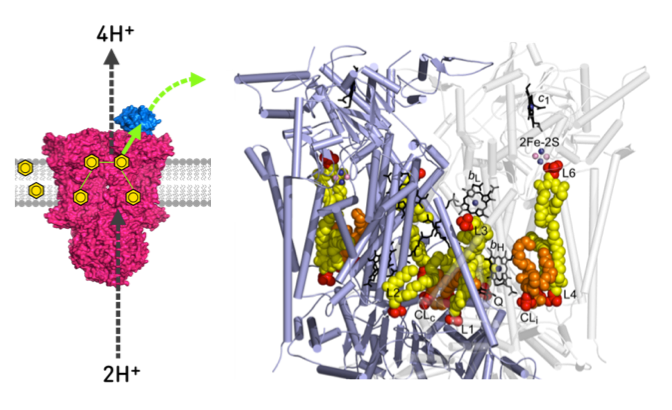The role of structural lipids for proton translocation of respiratory complexes
Translocation of ions across biological membranes is an essential process of life. It is enabled by membrane proteins and relies on tight integration of these proteins into the lipid bilayer. The tight seal is the prerequisite for the generation of electrochemical proton gradients which are the key to biological energy conversion. It is now generally accepted that specific interactions between individual lipids and proteins are crucial for function and structural integrity of membrane proteins [1,2]. Of special interest is cardiolipin (CL), the signature lipid of mitochondria. CL is essential for the function of respiratory complex III and other mitochondrial membrane proteins and also for the integrity of respiratory supercomplexes. Yet, the molecular mechanisms and underlying structure-function relationships are not understood. Disruption of CL biosynthesis leads to the Barth syndrome. This cardio-skeletal myopathy is caused by mutations in the gene of the acyl transferase tafazzin resulting in serious respiratory defects including loss of complex III activity.
Complex III is a central component of the mitochondrial respiratory chain. Embedded in the inner mitochondrial membrane, it couples ubiquinol-dependent cytochrome c reduction to proton translocation, thus generating proton motive force for adenosine triphosphate (ATP) synthesis. Mutations of complex III genes are associated with human pathologies such as exercise intolerance, cardiomyopathy, deafness, LHON, MELAS, and others. Furthermore, malfunction of the complex results in generation of deleterious reactive oxygen species (ROS), which are implicated in physiological processes of aging and neurodegenerative diseases. Complex III is also an attractive target for antimalarial drugs [3] and fungicides. Distinct lipid binding sites including two CL molecules were resolved in X-ray structures of yeast complex III (Fig. 1).

Figure 1: Left: Proton translocating mitochondrial complex III and cytochrome c (X-ray structure PDB 3cx5). Right: Close-up view of transmembrane region with bound structural lipids. Cardiolipin molecules are shown in orange, other lipids in yellow.
The main objective of this research project is to elucidate the role of CL and of other structural lipids for the function of proton translocating complex III and of related respiratory supercomplexes. We will address fundamental open questions with a broad spectrum of genetic, biochemical and biophysical methods including X-ray structure determination.
References
[1] C. Hunte and S. Richers. Curr. Op. Struct. Biol. 2008, 18, 406-411.
[2] A. Laganowsky et al. Nature 2014, 510, 172-179.
[3] D. Birth, W.C. Kao, C. Hunte. Nat. Comm. 2014, 4029; doi: 10.1038/ncomms5029
Contact
Prof. Dr. Carola Hunte
Institute for Biochemistry and Molecular Biology
Signalling Research Centres BIOSS and CIBSS
Stefan-Meier-Str. 17
79104 Freiburg
Phone: +49 (761) 203 5279 (phone)
Fax: +49 (761) 203 5284 (fax)
carola.hunte@biochemie.uni-freiburg.de
http://www.biochemie.uni-freiburg.de/ag/hunte



